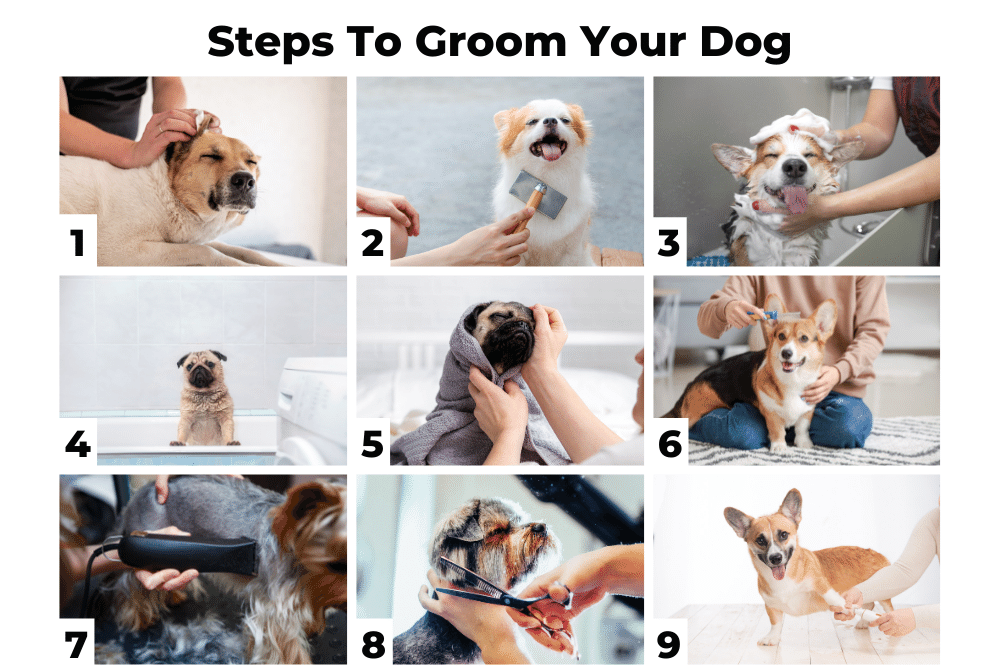You can keep taking your furball to the groomer or dog spa every month or so. Or you can learn the basics for how to groom a dog on your own. Then you can put some of that grooming money away for, say, more doggo snacks.
If your dog isn’t destined for the show ring but still needs (and deserves) to look and feel awesome, you could be his best ally. Learning even some basic grooming skills and having some good grooming tools on hand can help you maintain your sidekick’s appearance from home.
We’re realists, too, though. And we know that you know that some breeds get off easy while others need a veritable team of beautifiers to do a bang-up job.
One thing’s for sure: You need to know your specific breed’s unique grooming needs before getting scissor-happy or even pouring a bath.
Think Afghan Hounds and Shih Tzus with those long, Rapunzel locks. Or Komondors and Pulis with those crazy, car-wash cords. Or Old English Sheepdogs with double coats and all…that…fluff.
Yes, these beauty school valedictorians are some of the hardest dog breeds to groom. But there are plenty of basic grooming tips to help you bridge the gap between spa visits.
The steps to groom your dog will vary based on your dog’s breed and the grooming tasks you plan to achieve that day. Below is a list of the common grooming steps in the order that most professional groomers recommend, and we’ll review each step in more detail in this article.
10 Steps To Groom Your Dog:
- Start by cleaning their eyes, ears, and teeth.
- Detangle and brush their fur.
- Bathe your dog in lukewarm water with pet safe shampoo and conditioner.
- Let your dog enjoy the “wet zoomies” before drying.
- Dry before clipping or trimming their fur.
- Comb over your dog’s entire body.
- Use the grooming clippers.
- Use grooming scissors.
- Cut your dog’s nails.
- Add bandana, treats, and kisses…and take picture.
Before you start grooming, you’ll need to stock up on some basic grooming supplies.
Essential supplies for grooming your dog at home.
The right dog brush(es):
Not all dog brushes are created equal. And not all dog brushes are meant for all dogs.

You will need to do your homework to find the right brush(es) for your breed of dog. There are several different types of dog brushes: slicker pin brushes, deshedding rakes or undercoat rakes, pin brushes, double sided brushes, bristle brushes, mat breakers and rubber brushes.
Chances are you will have at least a few different brushes. Detangling, de-shedding, reaching undercoats, and smoothing/finishing are just some of the needs the right brush will meet.
A good grooming comb:
Combs can help with detangling, separating, and even removing fleas. Again, there are several different types of combs: flea combs, molting combs, and grooming combs.
You will probably have more than one kind of comb to meet all your dog’s grooming needs.
Grooming clippers:
Andis and Oster may be the professional clipper choices for vets and groomers, but there are plenty of great options for your home needs.
A good clipper kit should be one of your most enduring tools, so invest wisely. Choose a brand that is the best fit for your breed and the best fit for your hand.
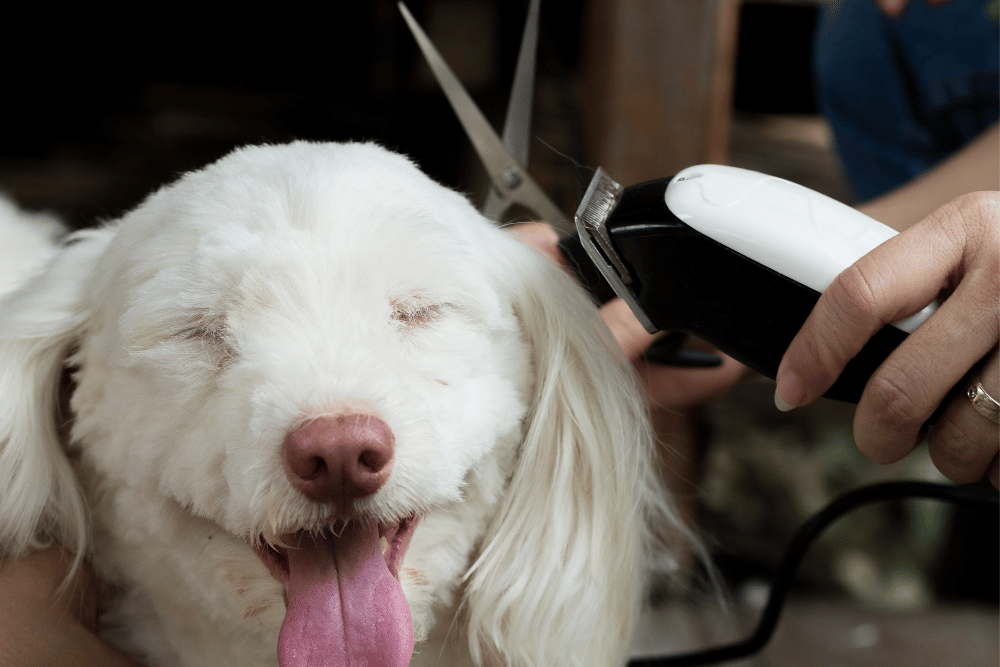
Also look for clippers that are quiet, have a large selection of attachable guards, and aren’t prone to overheating.
If you choose a cordless clipper, look for one with a long battery life.
A pair of grooming scissors:
A pair of curved grooming scissors and a pair of straight grooming scissors should be enough to take care of trimming most dogs. You might be able to purchase it as a grooming scissors set, we like the set by GLADOG because they come with ball point tips for safety.
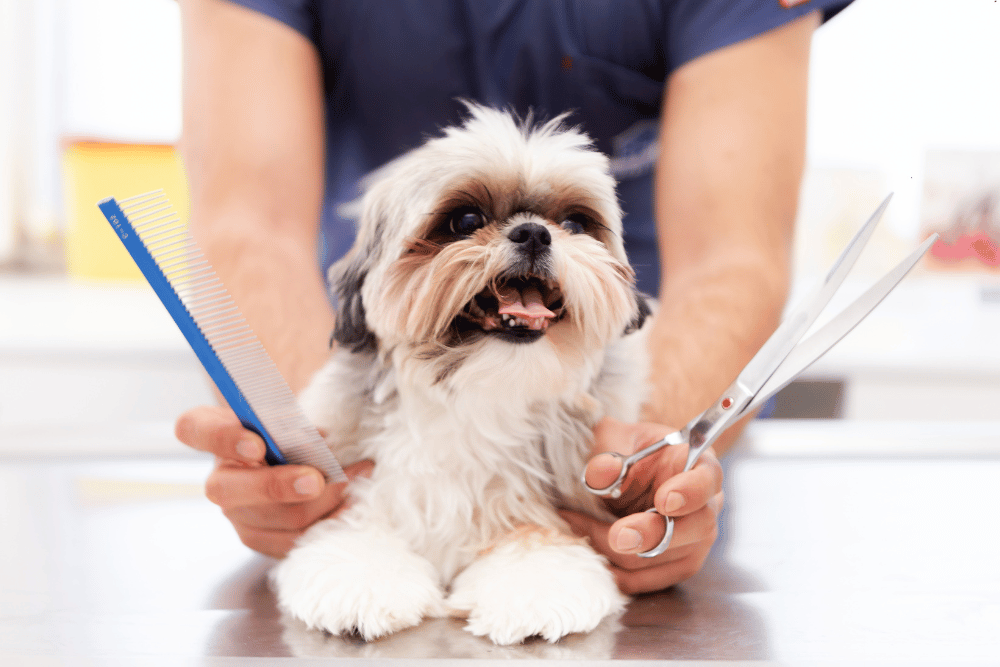
Whatever cutting utensils you use, make sure they are sharp.
Nail clippers with a safety stop:
As with other grooming supplies, the nail clippers you choose will depend on the size of your dog and the thickness of his nails.
If you’re wondering how to cut a dog’s nails safely, many professional groomers suggest using a rotary dog nail grinding tool to avoid the risk of cutting too close to the quick.
If you opt for a nail clipper, choose one that has a safety stop to protect the quick.
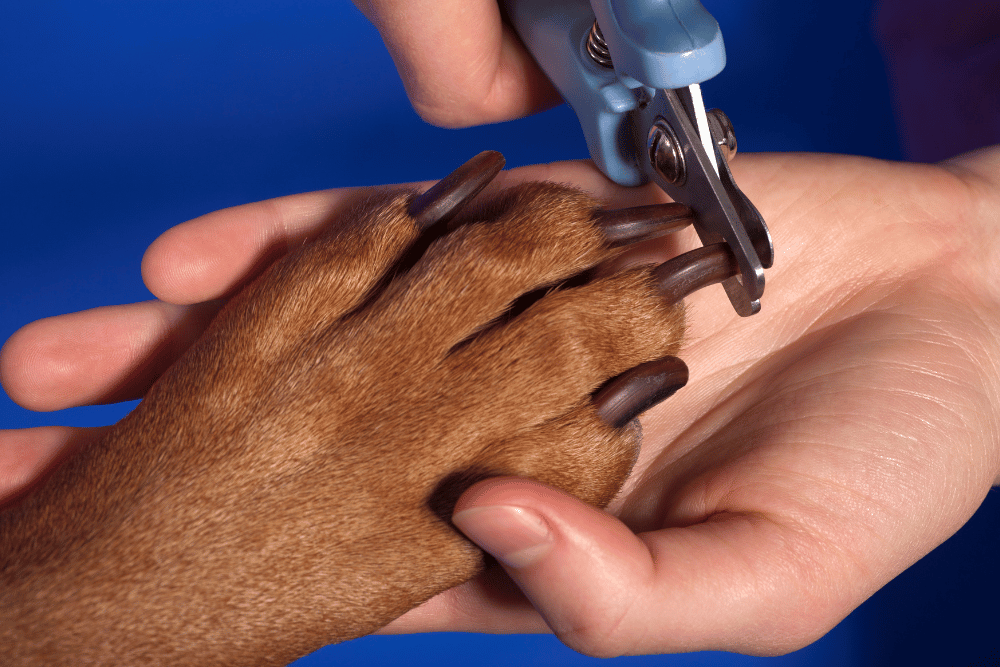
Styptic powder or baking powder:
You will need to keep one of these powders nearby while clipping your dog’s nails to stop bleeding if you accidentally cut the quick.
Dog shampoo and conditioner:
Choose a shampoo and conditioner formulated for dogs, not humans. Natural, plant-based products will be gentler to your dog’s fur and skin.
Our favorite is a 2-in-1 natural, oatmeal shampoo and conditioner by Mighty Petz.
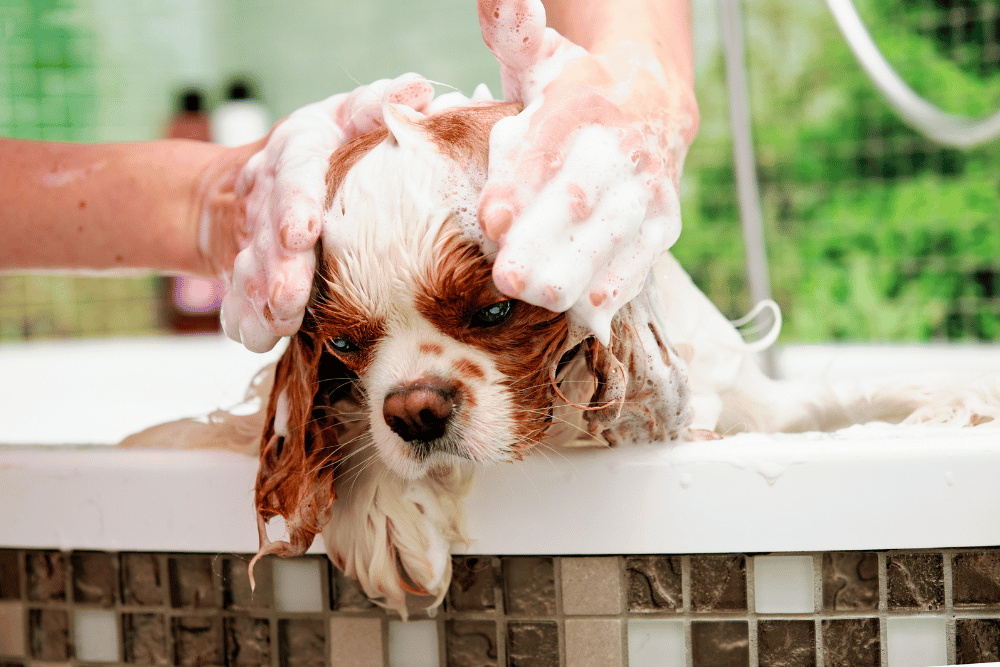
Pet safe bath wipes:
These bath wipes are great for quick clean-ups, especially in tight places like the eyes, mouth, and paws.
Ear cleaner for dogs:
Ear wipes are convenient for the visible interior of the ears. But to reach dirt and wax in the inner ear, use a liquid cleaner like Virbac Epi-Otic.
Toothbrush and toothpaste for dogs:
Routine oral care is one of the best things you can provide for your dog’s health.
Use toothpaste and a soft toothbrush made specifically for dogs.
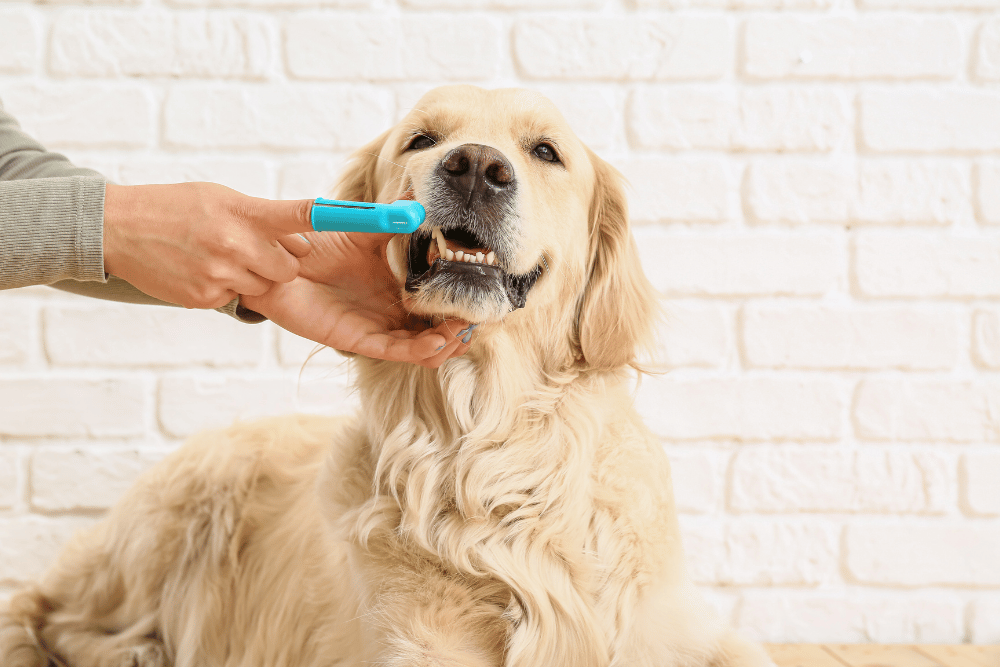
How to groom a dog: best practices and tips.
1. Start with eyes, ears, and teeth.
Wipe any goop or discolored discharge from your dog’s eyes. And use doggie eye drops to keep his eyes moist.
Then clean his ears with a liquid cleaner, and remove visible wax and dirt with a cotton swab or cloth.
Finally, gently brush your dog’s teeth (at least three times a week), with special attention to teeth in the back. And use this time to check his teeth, gums, and mouth for any breakage, gingivitis, or growths.
2. Detangle and brush.
Check your dog’s coat for tangles or mats, and carefully detangle or remove them.
Brushing your dog daily, especially if he has a long or complex coat, will make maintenance much easier and shedding more controllable.
Start at the head and move toward the tail, following the natural lines of your dog’s coat.
If it’s bath day, give your mud-magnet a good brushing first to remove surface dirt and loose, tangled, or matted fur. Brushing will help avoid clumping or tangles and unwanted fur in your drain.
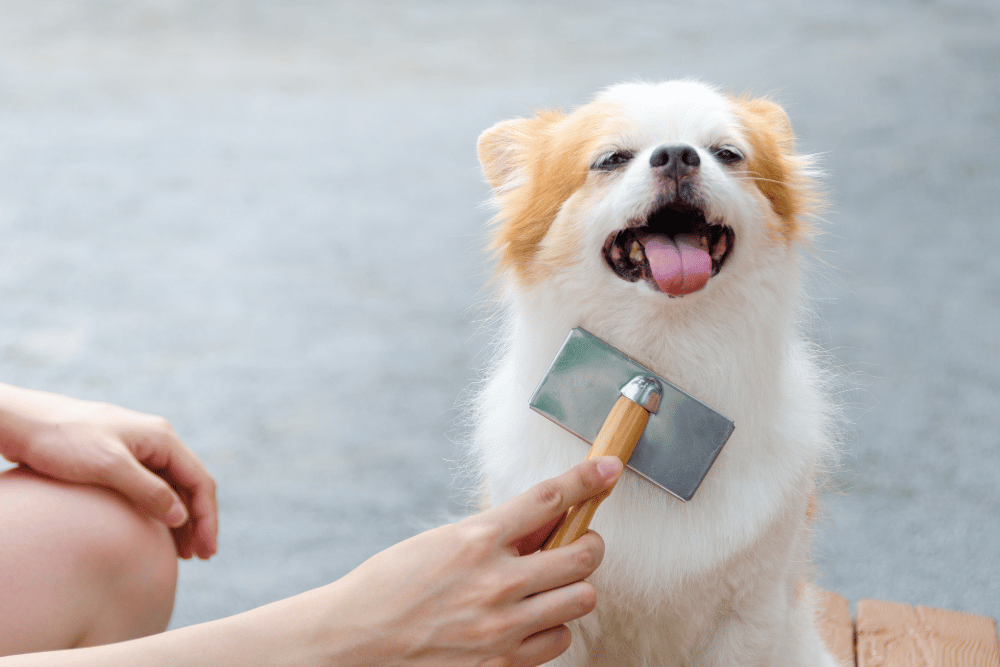
3. Bathe your dog in lukewarm water.
Pour shampoo into an empty, lidded plastic bottle, fill with lukewarm water, and shake. Then pour over your dog from head to tail and massage without clumping or tangling the fur.
Be sure to get the underbelly, underarms, and all the crevices of the paws.
Rinse thoroughly, then condition and rinse again, taking your time to remove all product from the fur and skin.
As always, check with your vet to learn how often you should bathe your dog, typically it is suggested that you can bathe your dog as frequently as every other week with a gentle shampoo. But do use your judgment. If your dog starts to smell funky or has been playing in the mud, it might be bath time.
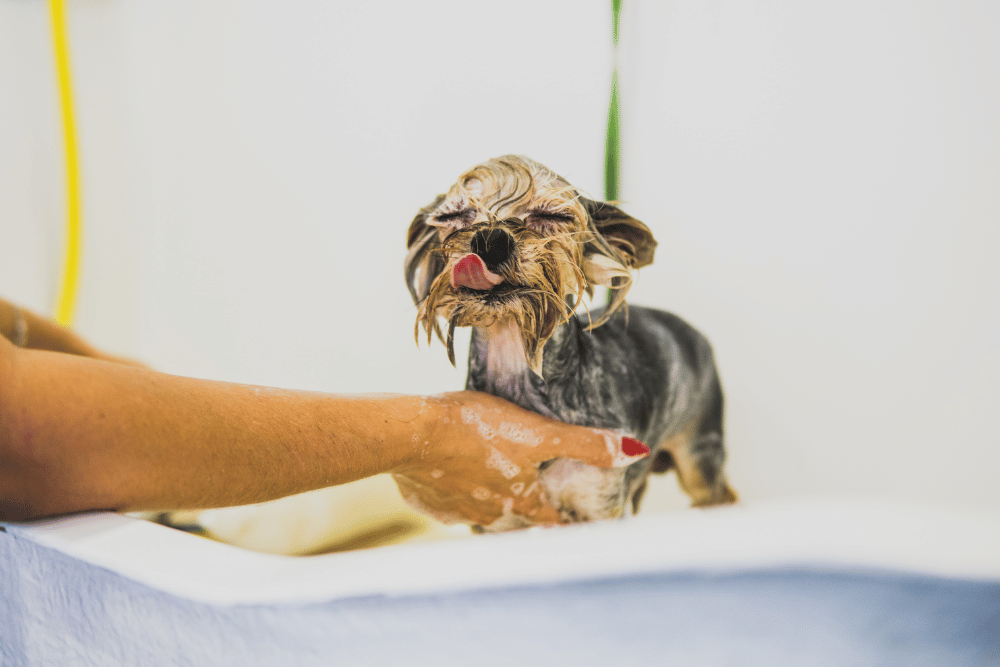
4. Let your dog enjoy the “wet zoomies” before drying.
Life is short. Zoomies are fun (and funny). Just let ‘em happen.
5. Dry before clipping or trimming.
Short-haired dogs can get by with a good towel-dry. Long-haired dogs, however, will need some help from a force dryer to blow off water and fluff the fur.
If you use a blow dryer, be careful not to use a hot setting or hold the dryer in one place.
6. Comb over your dog’s entire body.
Combing will straighten the fur and prepare it for clipping and trimming.
7. Use the grooming clippers.
Start at the neck and move toward the tail.
Use larger guards and progress toward smaller ones until you are comfortable with your technique. Learning to use clippers to groom a dog takes practice, so work slowly and conservatively.
And always move in the direction of your dog’s natural fur growth.
Carefully use the clippers to clean up the underbelly and private areas.
8. Use grooming scissors.
Start at the legs, combing first to determine your desired length and lines. Then use the curved scissors, curved side in, to trim the legs.
Move on to the paws, trimming fur from between the paw pads with clippers and/or straight scissors.
From the legs, move onto the ears and, if applicable, the beard, brows, and tail.

9. Cut your dog’s nails.
Cut nails at a 45° angle, being careful not to cut the quick that runs through the center of the nail.
The quick is a blood and nerve supply, and cutting into it is extremely painful for a dog.
If you do accidentally cut it, it will bleed until you cover the tip with styptic or baking powder, so keep a container of powder within reach.
10. Add bandana, treats, and kisses…and take picture.
Your work is done, and it’s time to celebrate looking and feeling good!
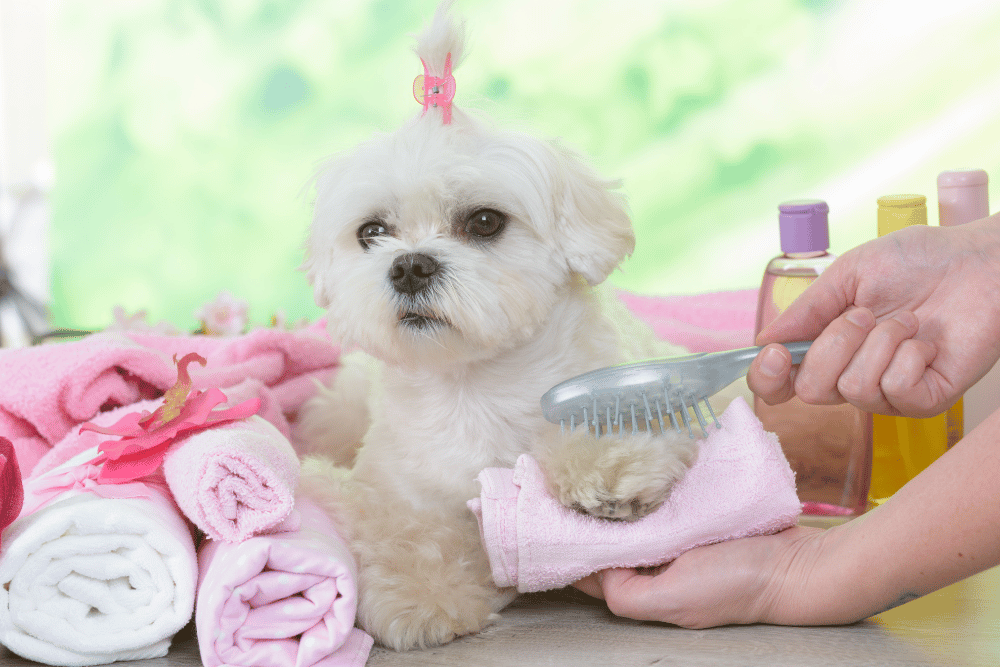
In our experience
Whether you have the drip-dry model or the diva model, learning the basics of how to groom a dog is a must for any dog parent.
After you have gathered together all of your dog grooming tools, consider designating a grooming area in your house for dog grooming or even making a DIY dog grooming station. This will make it easier and more efficient each time you need to tackle the task of grooming your dog!
Even if all you do is alternate professional dog grooming with home-grooming, you will both benefit.
Not only will you keep your dog in tip-top shape, you will also deepen your bond with him.
